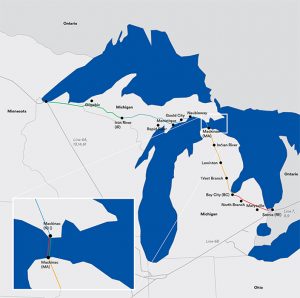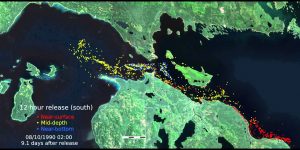Enbridge Inc., Line 5 and the History that Causes Concern for the Great Lakes Region
Written by: Elizabeth Coleman
Is Enbridge Inc. just another business minded corporation? Although they claim on their consumer-friendly website to “consistently strive towards a neutral footprint on the environment” and “relentlessly ensure the safety of [their] communities, customers, contractors, partners and employees”[i], Enbridge’s history has cause for concern. Enbridge, Inc. is a Canadian Oil Company that has a network of oil lines mapping beneath most of the Great Lakes region. As investigative journalist, Spencer Chumbley, puts it, Enbridge has a “concerning record in the state of Michigan.”[ii]
The issue at hand is concerning Line 5, an oil pipeline running from Superior, Wisconsin all the way to Sarnia, Ontario, Canada and a “vital piece of Michigan energy infrastructure since 1953”[iii]. The line travels through the Upper Peninsula of Michigan and splits into two 20-inch-diameter pipes running along the bottom of the 5-mile-wide Straits of Mackinac between Lake Michigan and Lake Huron.
“The Line 5 Straits of Mackinac crossing remains in excellent condition and has never experienced a leak in more than 60 years of operation. We’re working hard to keep it that way.”[v]
As it was commissioned, Line 5 was only supposed to be in service for 50 years, says retired Engineer Bruce Trudgen in an interview with Chumbley where he recalls when he began working on the Line back in the 1950s.[vi] The Line is now in its 65th year of commission with no visible end and has yet to have any pipes replaced. Especially for the people of the Great Lakes Region, the Line poses a threat to “drinking water, income, inspiration, and a sense of pride to tens of millions of people and their communities.”[vii] Although Enbridge prides the Line on having never experienced a leak in all of its years of commission, the 23 million gallons of oil and petroleum following through the pipeline could cause devastating consequences within seconds of a tear or rupture in one of the two pipes.[viii] In an interview with Chumbley, Dr. Dave Schwab of University of Michigan said that the best case scenario from only one rupture and immediate shut-down of the pipe would be a spill of a minimum of 1.5 million gallons of oil and petroleum. Schwab had created a digital simulation of how quickly and vastly the spill would spread from natural current flow of water between the two lakes.
Dr. Schwab analyzed, “I can’t imagine another place in the Great Lakes where it would be more devastating, in terms of the amount of shoreline that would be impacted and the speed that it would be impacted at.”[x] Shore contamination could highly impact the many fisheries of the region.[xi] Many groups, especially tribal nations from the Great Lakes region, have come together to stand against the possibly impending rupture of one or both of the pipes lining the bottom of the Straits of Mackinac.[xii]
In an interview with Chumbley, Jason Manshum, Enbridge Inc. Communications Manager, was quick to defend his company saying, “The notion that a company like Enbridge would not maintain a line, that’s just atrocious. It’s quite false.”[xiii] However, the company’s history refutes this statement. As researched by Chumbley, Enbridge’s disclosed data shows that between 1999 and 2010 over 5 million gallons of oil were released in over 800 spills in both the U.S. and Canada.[xiv] Furthermore, in 2010, Enbridge Inc. had the largest oil spill in the history of America. Over 800,000 gallons of oil from Line 6B spilled into the Kalamazoo river and traveled 35 miles downstream. The spill had a vast impact and took a budget of 1.2 billion dollars and efforts until 2014 to clean-up.[xv] Keeping this history and data in mind, I find it hard to believe that the corporation is as cautious as they market themselves to be.
In an attempt to better understand the issue regarding Enbridge’s Line 5, all of these historical, environmental, cultural and social impacts must be acknowledged. Through basic knowledge gained regarding the corporation’s past, the question must be asked: Are Enbridge Inc.’s priorities placed elsewhere than what they claim?
Notes
[i] “Our Values.” Enbridge Inc., www.enbridge.come/about-us/our-values.
[ii] Chumbley, Spencer. “The Dirty Secret at the Bottom of the Great Lakes: Oil & Water.” Motherboard. 2015. Vice Media, LLC.
[iii] “About Line 5.” Enbridge Inc., www.enbridge.com/projects-and-infrastructure/public-awareness/line-5-michigan/about-line-5.
[iv] “About Line 5.” Enbridge Inc.
[v] “About Line 5.” Enbridge Inc.
[vi] Chumbley. “Oil & Water.” 2015.
[vii] “Line 5 Pipelines and Extreme Energy.” FLOW (For Love of Water): Empowering Communities and Leaders to Protect the Great Lakes., flowforwater.org/programs/enbridge-line-5-pipelines-in-the-straits-of-mackinac/
[viii] “Line 5 Pipelines and Extreme Energy.” FLOW.
[ix] https://www.youtube.com/watch?v=t_0AsAAHpcs
[x] Chumbley. “Oil & Water.” 2015.
[xi] “Pipeline Spill Danger.” Oil & Water Don’t Mix: Keep Oil Out of the Great Lakes., http://www.oilandwaterdontmix.org/pipeline_spill_danger
[xii] “Tribal Supporters.” Oil & Water Don’t Mix: Keep Oil Out of the Great Lakes., http://www.oilandwaterdontmix.org/tribal_supporters
[xiii] Chumbley. “Oil & Water.” 2015.
[xiv] Chumbley. “Oil & Water.” 2015.
[xv] Chumbley. “Oil & Water.” 2015.


